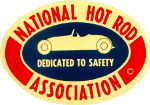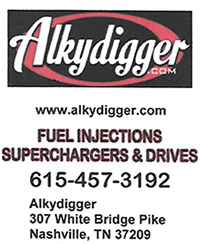Taken from the 1962, Official NHRA Rule Book pertaing to the Gas – Coupe/Sedan Class aka Gas Class or Gassers for short.
1962 Official Drag Rules
III Street Section

The street section is for “dual-purpose” cars capable of starting under their own power. Cars in this section must be capable of being driven on the street. Bodies, engines, drive trains, etc. may not be altered, moified or relocated except as noted in class requirments. Push starts not allowed. Return to the pit area by use of a push car is permited, but only if so noted in the division Class Requirments. Any pre-1960 unblown 4-cylinder automotive production engine cars may complete in the ‘flathead’ classes of this section with any type of head.
A. Gas Coupes and Sedans Division (G)
Seven (7) classes of competition in this division for non-supercharged cars. Class is determined by the total car weight divided by total cubic inches of engine displacement.
Designations: A/G, B/G, C/G, D/G, or E/G preceded by car number
- Class ‘A’ – 4.0 0 to 8.99 # per cu in
Class ‘B’ – 9.00 to 10.99 # per cu in
Class ‘C’ – 11.00 to 12.99 # per cu in
Class ‘D’ – 13.00 to 14.59 # per cu in
Class ‘E’ – 14.60 or more # per cu in
Designations F/G and G/G preceeded by car number
- Class ‘F’ — 5.00 to 10.99 # per cu in
- Class ‘G’ — 11.00 or more # per cu in
For non-supercharged pre-1969 flathead V8’s, in-line six-cylinder and straight 8 engines with stock production heads
B. Supercharged Gas Coupes/Sedans (GS)
Three (3) classes of competition in this division for car equiped with super-charged engines.
Designations A/GS. B/GS, C/GS preceeded by car number
- Class A — 5.00 to 8.99 # per cu in
- Class B — 9.00 to 12.59 # per cu in
- Class C — 12.60 or more # per cu in
Class requirments for Supercharged Gas Coupes/Sedans division are the same as those outlines for all cars in the street section, except as noted below.
Starter: Engines must be started started under car’s own power. Push cars are permitted to return car to the pit area following a run.
Classification: No advance in class for use of supercharger.
STREET SECTION CLASS REQUIRMENTS
Ballast: Permited. Refer to Ballast as outlines in Safety Rwgulations
Bellypans: Bellypans are permitted in Modified Sports classes only.
Body: Gas Coupes/Sedans — Must have a coupe or sedan body orginally produced by an American automobile manufacturer. (There are at present a few foreign coupe and sedan bodiesd cars taht in general characteristics better meet the requirments if the Gas Coupes/Sedan class than sports car class. Provided these car bodies and cars do meet all other class requirements — wheelbase etc. — these cars are classed according to cubic inch displaement to weight under this section.) Moderate customizing is permitted, but bodies may be chopped, channeled, or sectioned not more than four (4) inches total height reduction. Bodies can not be otherwise altered in height, width, length or contour. Roll bars are required in all customized cars (i.e., chopped, sectioned, etc.), and all Supercharged Gas Couples/Sedans. LIghtening bodies by driling hoes or gutting interior is not permitted.Sedan delivery and sedan pickups (1/2 ton panel trucks, Ranchero, El Camino, etc) may compete in this disision, only if they meet all the class requirments. Pickup beds must ve of standard height and width, a minimum of 36 inchs in length, and have a full serviceable pickup bed. All cars in this division must have fully operative mechanical door handles to permit exit and or entrance for either side. Bodies and/or frames may not be raised ro gain weight transfer to the rear wheels.
Brakes: All cars in the Street Division must be equipped with four-wheel hydraulic brakes. Emergency brake is optional.
Bumpers: Bumpers are not required; however, in lieu of rear bumper, a suitable (permanemtly arttached) push-bar must be installed on the rear of the car.
Drive Line: May be modified or fabricated to fit altered units. Refer to Drive Line Safety Requlations.
Driver: Automobile engine required: however, year, make and model are optional. Any modifications maybe made to the engine and/or component parts, including clutch and flywheel. No more than one engine permited. Engine may be relocated, but not to exceed 10% of the wheelbase as measured form the centerline of the front spindels to the nearest spark plug hole. Engines may not be rasied more than 24 inches for the ground, measured from the centerline of the front crank pulley to the ground. Rear engine location is not permitted in the Street Section, unless it is abnd orginally produced/manufactured rear-engine car, retaining original engine.
Exhaust System: Open exhaust, split manifolds and/or individual headers are permited, but must terminated in a collector at least 6 inches in length. A maximum of two outlest per car. All exhaust systems mist be so designed as to route exhasust gasses away from the car, body, tires and strip. Mufflers and tail pipes are optional.
Fenders: Gas Coupes/Sedans – Must have 4 full stock production fenders. Exact duplicates of stock fenders made of fiberglass are permited. Fenders make be altered for clearance to permit the use of wide slicks. Moderate customizing we be subject to approval of the technical committee.
Fender Splash Panels: May be trimmed for header clearance, but may not be removed.
Flywheel Sheild: Required on all cars in this section except one equiped with a pre 1961 Hydramatic transmission.
Frame: Must be stock automobile type frame. Properly reinforced stepped frames are excepted. Cross members may be altered or relocated.
Hood: Required in all cars in this section. Side panels may be ommitted, All carburetors, injectors bodies and supercharges must be completelu cvered buy a bubble or scoop, which must be part of the car’s hood. Injector tubes abd supercharger air scoops amy extend through the hood. Flash shields etending through the hood are not accepted.
Radiator & Grill: Required. Must have a stock passenger car-type, as large in overall frontal area as the original radiator shell, mounted ub a conventional forward location. Radiator shell may be shortened in height to permit hood installation or ground clearence in street roadster classes only, but not to exceed the amount of body channel.
Street Equipment: All cars in Street Section must be able to start under their own power. License plates, generator, windsheld wippers/motors, fans and fan belts, and horns are optional. Headlights and tail-lights as required for legal on the street operation are requird for competition.
Suspension: Each car in tis section must have a full production type suspension system; one commonly used by an automobile manufacturer. Rigid mounted axles are not permited. Excessive chopping and machining of component chassis and suspension parts is prohibited.
Transmission: Must have a full transmission, either standard or automatic, with full shift pattern and gears for the transmission used. May be of any year, make or model. Any gear ratiob accepted. A minimum of three forward and one reverse speeds required on all stick shift (manual) transmissions. Transmissions must remain in conventional location, determined by engine used.
Upholstery: Interiors may not be gutted. Must run full upholstery, equivalent to facotry specifications. Floor mats optional. Bucket seats may replace stock seats (two required), only if they rea fully upholstered. Rear seats when car is equipped from factory, must remain in the car during competition.
Wheelbase: All Gas Coupes/Sedans, Supercharge Gas Coupes/Sedans must retain stock wheelbase length ad tread width for the type of car body used. Minimum wheelbase length is 92 inches.
Wheels & Tires: Each car competing in Gas Coupes/Sedans class, Supercharged Gas Coupes/Sedans classmust be equipped with automotive type wheels and tires suitable for street use. Magnesium disc-type wheels are permitted for use on the rear. Lightweight automotive-type wire or motorcycle wheels are not permitted.
Windshelid & Windows: Windows may be replaced with Plexiglass of 1/8 inch minimum thickness.
Taken from the 1962 NHRA Official Drag Rules Book



